Merry Chirstmas to everyone, between decorating the tree and eating myself to death I found some time to make a project thread for this. (Note: this project covers a period of three centuries, this way two boards here, but I think it better fits in this one).
Clashes between Hungary and the expanding Ottoman Empire began in the 14th century, but as the Balkan states fell, the problem became more acute in the mid 1400s. The great Hungarian politician and war leader, János Hunyadi led the war efforts against the Ottomans, leading campaigns onto the Balkans, earning himself a grim reputation amongst the Ottomans, the Hungarians, and almost all the Balkans nations. He was actually the boogeyman Turkish mothers threatened the disobedient children with! His greatest victory was the one at Nándorfehérvár (todays Belgrad) in 1456, the pope ordered all churches to chime the bells at noon to celebrate this victory, a custom still alive today.
János Hunyadi died soon after this, but in 1458 his younger son, Mátyás Hunyadi claimed the Hungarian throne. Also called Matthias the Just, he brought a golden age to Hungary, both in cultural and in political point of view- Hungarian folks tales have an actual subgenre of the funny legends of his deeds. He formed an army called the Black Army, a huge and modern mercenary army he successfully fought his enemies with on the West and on the South (the latter being the Ottomans

)
He died in 1490, but without a legal heir, this was a huge mistake since his successors were far less powerful and competent. The Ottomans, under the great Suleiman, saw the opportunity, and by 1540, Hungary fell into three parts: the North-West remained the official Hungary, the Hungarian crown now on the heads of the Habsburgs. Transylvania became an independent, Hungarian-led country, always under the shadow of the Ottomans. And the central part of the country simply became a vilajet (province) of the Ottoman Empire.
This, however, was not a stable situation, this was the time of "there is only war": lots of big campaigns and constant small scale skirmishes between them. Time of great stories, great heroes, great adventures- and great destruction

It all ended in 1686, when a great crusade was organized by the pope to liberate Hungary. This was now the emerging new Europe versus the declining Ottoman Empire, and came to a quick conclusion: Hungary was liberated and reunited, and the peace made with the Ottomans in 1699 became a long lasting one (two smaller wars were fought in the late 1700s and in 1878, and we became official allies in ww1 and now in NATO

).
My collection concentrates on the Black Army of King Matthias, with some additions which will be usable in the 16-17th century.
The Black Army I collect as a real, big army. It is easy to collect since as a mercenary army, the soldiers came from everywhere: the deep core was actually a Hussite Czech marauder called Jan Giskra, who was pillaging Northern Hungary. Matthias came and beat them, but as they surrendered, they were forced to choose between two options. Option A was being executed, so they chose Option B, serving the king with their great war experience gained in the Hussite wars. And this is just an example, in the end any 15-early 16th century European figure fits the Black Army (except maybe the English longbowmen), just add Hungarian insignia. The name Black Army comes from the fact that after the king died, they all wore black ribbons- their clothing was varied and colourful, just like any other European army of that era.
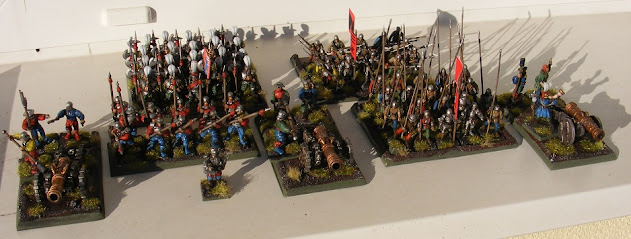

The black Army had three basic components: heavy infantry as an anvil, heavy cavalry as the hammer, and light cavalry for harrassment and reconnaissance.
Lets start with the infantry. This guy was the first concept model, I just bought a huge WHF Empire army, and with some minor conversions, they fit very well.

Then came this little warband:

I liked the colour scheme and the figures, so now I could make real units. Halberdiers from Perry:


Pikemen also from them:


These pikemen are from WHF. The colour of Hungary is red and white, while the colour of the Hunyadis are red and blue, so I tried to use these a little bit more.

Old WHF Empire halberdiers. Could not resist the unified scheme.

Further halberdiers, figures from various sources. Most of them WHF Empire militia.
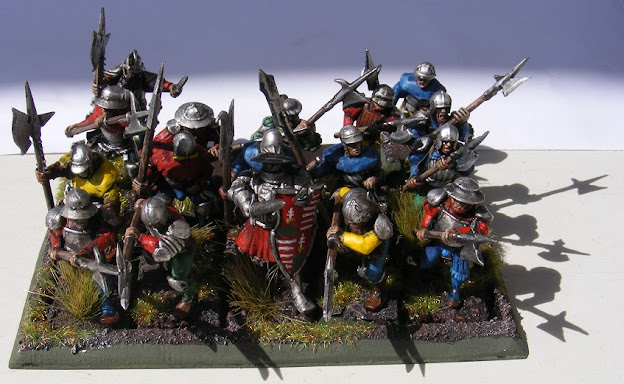
Gunners I made the same way.
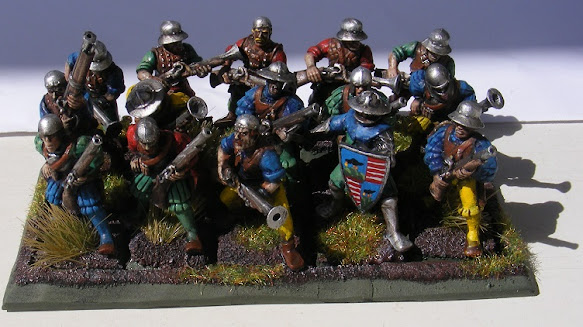
The cannons also come from WHF. I think they fit well. Some head swaps were needed for the crew.



Heavy cavalry. They were recruited from amongst the Hungarian nobility, basically the same as in any contemporary European country. One of the biggest feat of János Hunyadi was making the often unruly knights into a very disciplined military force, and this alone wona lot of battles for him. The models are again from WHF, with head swaps so that they have the salade helmet characteristic for the late 15th century. I painted all of them to bear an insignia of a Hungarian noble family, one guy came with that pegasus head helmet, I even incorporated him without a change as the white horse was the insignia of the Szapolyai family.



Light cavalry. Now this is where the fun begins- proper figures are really hard to get, so I had to sculpt.
There were two types essentially, one being the last remains of nomadic horse archers, the other, most dominant one the Hussars. You most likely heard about the Hungarian Hussars, now this is where it all began. The first Hussars were Serbian bandits who joined the ranks of the Hungarian army, but Hungarians quickly learned (never forget?) their ways of fast light cavalry actions, so soon they were mostly Hungarians. The first Hussars had shields and lances, during the 16th century they turned towards swords and later they got pistols too, so thats how their well-konown image was formed. (Interesting side note about this evolution: the monarch of Transylvania, István Báthory became a Polish king in the late 16th century, and he introduced the Hussars to the Polish. Our Polish friends had other concept in their minds, instead of dropping the heavy equipment, they added more! Thats how the Winged Hussars, essentially a heavy shock cavalry unit, were born.)
I started the sculpting with a horse, as I've shown it in the 1848 project:
https://leadadventureforum.com/index.php?topic=138150.0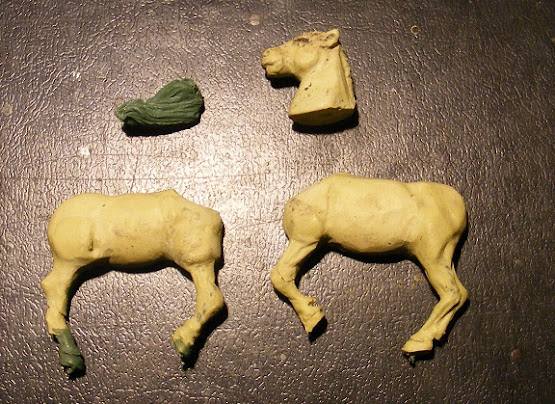
Then I added the proper equipment:

Then I sculpted the rider. First among the many, I will sculpt more bodies and heads, now I am at this first concept being done. he can be used from the Black Army to the late 16th century.



Light infantry. In the Black Army they were just auxilia, but in the later stages, in the 16-17th century they became the main force. The standard equipment for Hungarian infantry in the early 1500s was sabre and handgun, this became so characteristic, that it was called ,,being armed the Hungarian way" .
For the 16-17th century I will concentrate onto the smaller skirmishes. Character-based skirmish campaigns feel forced in most historical settings, but here this is the best approach: the border between Hungary and the Ottomans were dotted with castles, and the fight went back and forth for these (some of them frequently changed owners). They are called in Hungarian "végvár", the "castle on the ends", and it really captures the essence: the Habsburgs saw Hungary nothing more than a buffer zone between Wien and the Ottomans, so the soldiers stationed in these castles were mostly on their own. They know well their oppoents in the Ottoman castles, duels, skirmishes, raids and ambushes were frequent amongst them if not for duty then for bravado and loot.
Two figures are sculpted for now, one the typical infantryman of short handgun and sabre:
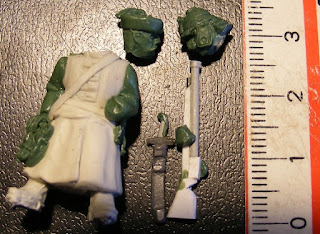


The other in heavier equipment. This type of helmet is known from ECW in the West, in Hungary it was common in the 15th century too. It came from the Ottomans, originally called "chichak", made a huge impression here, "sisak" became the general Hungarian word for helmets.
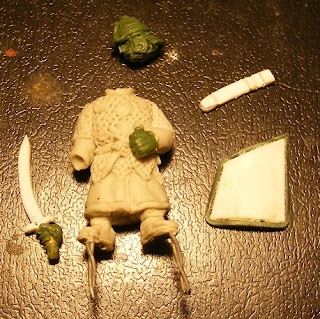

With some minor adjustments both can be made into Ottomans too.
That is it so far, a project again with so much to do I can not even begin to list. I will track the additions here.